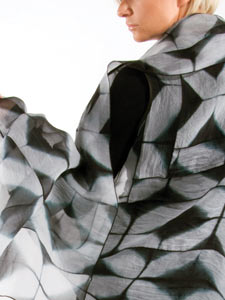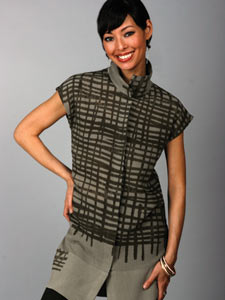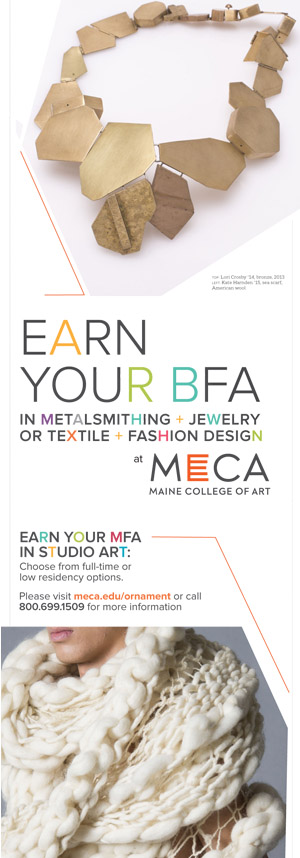
JACLYN DAVIDSON
More like those old mercantile traditions of the bazaar or marketplace than a supermarket or chain store, the Philadelphia Museum of Art Craft Show should be recognized for being an essentially American enterprise showcasing entrepreneurially minded artisans.
As autumn comes around and moves into winter, many are looking for respite from what has been quite a turbulent year for the world, our planet Earth. Spring and summer’s natural association with change and growth have been well represented. After all this hubbub, the subsiding of fall, that transition from the activity of the summer to the cocooning of winter, is welcome indeed. As a place of regeneration during this period, the Philadelphia Museum of Art Craft Show is just such a refuge, taking place from November 10 – 13 at the Pennsylvania Convention Center. Celebrating its thirty-fifth anniversary, the show, with some one hundred eighty American artists, has provided a haven for craft in Pennsylvania, and indeed the larger East Coast area, drawing from Europe as well.

It is the combination of atmosphere, a well-chosen stable of craftspeople, and the rotating element of an international invitational that makes the Philadelphia Museum of Art Craft Show the extraordinary one that it is. Change is the spice of life, but foundations are mighty comforting. A good life keeps a balance of both, and it is that which is so warmly expressed here.
The guest artist program and the emerging artist section, now in its fourth year, serve to bring in new sights, and in the case of the guest artist program, frequently new sounds as well. Started in 2001, and interfacing with craft organizations within the country itself, the guest artist program brings approximately twenty-six artists from a foreign country to the American mainland. This year, Scotland participates for the first time.
What is primarily important in change is contrast. Each country tends to have its own aesthetic, and thus provides a vital element to the venue. This year with Scotland, we see an eclectic mix that somehow manages not to replicate and simultaneously complement our own wonderful work from the United States. Resin jewelry by Carla Edwards, industrial liquid enamel utilized by Stacey Bentley, flowing feltwork dresses by Elizabeth Gaffney, all implementing a twist of material and look, these examples seem to represent the flavor of the Scotland contingent, a certain zaniness. While the use of alternative materials is becoming more and more accepted, seldom do you find a country’s work represented largely by it.
Jilli Blackwood, with her felt dresses, kilts and wall hangings, is one such measure. Slashed, ragged and draped, her clothing is untidy ... and delightfully rich. Whether from sumptuous textural work, with many of her dresses pleated, or from layers of brightly colored fabric, Blackwood’s clothes feel hearty rather than ethereal. Strands of fabric hang from her skirts like straps from leather kilts. Messy and unkempt, the designs have a wildness about them.

Jeweler Gilly Langton introduces elastic into her silverwork, creating bangles and necklaces that are reminiscent of Massai jewelry. However, because of the rubber the pieces are distinctly contemporary; a real fusion between the ethnic and the urban. Her silver-only rings are minimalist pieces, with a distinct modernist aesthetic.
The emerging artists also seem to be well chosen, with a distinctive spread. Last year, several artists in the emerging category utilized alternative materials in unique applications, such as Peter Boerger’s wooden glasses. This year, many of the artists employ techniques less often seen in the craft show circuit. Monika Knutsson, a jeweler formerly from Sweden who now resides in New York, merges textile and metalsmithing disciplines. Handstitched lace is sealed, then probably gilded in gold or silver. The end result is almost like an ethnographic piece, and seems to mirror Balkan or Russian jewelry. Also, for those who are lacemakers themselves, Knutsson’s use of a wide variety of lace patterns gives insiders to the trade that extra zest of recognition.
Tia Kramer, a paper and metal jewelry artist, likewise brings work that expands the visual field. Her work employs bold colors and simple geometric shapes to create a jazzy jumble of wires and pennants. If you have seen a mirrored wind chime casting orbs of light across the ground, you can see a parallel to how Kramer’s work illuminates the body with color. With their lightweight construction, they serve to throw highlights of color onto a person’s body.
Several of last year’s emerging artists are now showing as regular exhibitors, such as glass jewelry artist Melissa Schmidt, folded paper jeweler Francesca Vitali and wooden spectacle crafter Peter Boerger. This illustrates the emerging artist section working as it should: a graduation point whereby craftspeople who have not previously entered the circuit can be introduced, and subsequently become new regulars of the craft show.

With this year’s show, craft continues to progress, evolve and multiply, particularly in the elegant employment of novel materials. Yong Joo Kim, a jewelry artist originally from Seoul, Korea, utilizes recycled velcro to produce richly textured black and gray scarf-like necklaces, or cuffs that seem to be carved from pepper black and white wood. The velcro, limited in coloration to black, white, red, or a light gray, has this in common with paper as a material in that it must be layered.
Kim plays with form, as the structural limitations of velcro are the most challenging element with which to experiment. Disc-like shapes, reminiscent of old vinyl records or film spools, are used either as brooches, or as the building blocks to create larger pieces. Building on the same theme, the layered velcro can be made into spirals, or concentric circles as an unusual bracelet. Throughout this, the satisfying monochromatic coloration of the velcro, barring occasional and judiciously placed strips of red, makes for a compelling and tactile aesthetic.
Texas jeweler Fred Tate has for years employed black bamboo into his silver and gold jewelry, along with Italian coral and Tahitian pearls, as another kind of precious material. Placed between the coils of a bracelet or inserted cross-wise as the centerpiece for a ring, the organic material cannot be tamed into being subdued by the inorganic, and thus brings a new dimension to the more traditional materials. Also serving as a framework, for either embellishment or as a structure upon which to build or support further components, the bamboo is the protagonist of the piece, and as much a jewel as a precious mineral.

What is reassuring and commendable about the Philadelphia Museum of Art Craft Show is that it not only has been admitting excellent talent in novel craft mediums, but has always maintained a core of some of the best craftspeople in traditional mediums. Seeing both the younger generation of evolving craft artists like Francesca Vitali, Yong Joo Kim, knitted clothing artist Kaoru Izushi, and Monika Knutsson with the older generation of established craft artists, who have continued to develop their craft and to simplify or complexify their work towards beauty, constitutes a wonderful environment of true diversity. With this year’s show, it feels like a robust equilibrium has been reached.
Kathleen Dustin, one of the most advanced polymer artists in the nation, and a true tour de force, is an established artist whose work contributes positively to any show. What defines Dustin’s excellence is not only her mastery of technique, but her willingness to explore the wilderness in search of that next level. Constantly challenging herself, Dustin’s latest transformation has been from her Pods and Plants series, which are highly representative, to her most recent work, a sublime conception of symbolism and abstraction. Accomplishing almost enamel-like layering with thin sheets of polymer clay, Dustin’s pieces have a surface translucency which is remarkable, and allows for different colors and shapes to be visible beneath the outer layer. That Dustin has achieved this effect with polymer clay is the evidence of her continuing ingenuity and mastery of the medium.

Carver Norm Sartorius has the enviable position of knowing wood. Needlewood, afzelia, manzanita, African blackwood; like gems from the depths, this panoply of materials in their cherry red, ebony, moss green, and bone white all come from one thing, the tree. Sartorius takes burls of these precious substances and molds the wood into languid teardrops, roiling twisted handles and subtly lustrous bowls— in fact, a spoon. Sartorius is careful to call his work non-functional, or spoons as sculpture. According to his artist statement, “non-functional in that you wouldn’t use them in the kitchen, but functional in that they are objects of beauty.” One can quickly see Sartorius’s love for the medium of wood in the constant variation of his pieces, all taking the material into account. Where the natural, uncarved wood would provide a more robust aesthetic, Sartorius tampers not, simply carving out just enough to form the bowl in graceful correspondence.
Goldsmith Barbara Heinrich is another long-attending member of the craft show who demonstrates this confluence of technique and an insatiable desire for self-improvement. Heinrich has produced voluptuously curved bracelets and delicate leaf and flower motif brooches and necklaces in the last few years. Her Gold Blossom brooch won first place in the gold distinction category of the MJSA Vision Awards this year. Tracing only the bare contours of a flower’s petals, resembling a chrysanthemum or open rose, the only component besides the gold is a few diamonds studding the piece’s center. A gold leaf necklace makes similar spartan use of the material to render the leaf to its essential outline. Architectural works, they seem to convey the elemental structure of the natural form.

Reverberations upon silk, wool and linen, Amy Nguyen’s coats, jackets and scarves are, as the artist says, “ancient and contemporary—light and shadow—form and space. These opposites are explored in my artwear. The art of shibori has been an artform that embraces both planned manipulation and an unknown nature.” Oscillating between midnight hues and white sheen, as tiled pieces or waves and stripes, Nguyen’s layered silk and wool or rougher linen patches all play off that contrast between light and dark with infinite permutations. The cut of her clothes is also highly attractive, with certain coats being made, kimono-like, from strips of layered silk or wool, but always with a drape and style that suggest both grace and action. These feel like clothes you can move around in rather than be sedate, yet they act as well in rest as they do in motion.
Michigan basketmaker Samuel Yao weaves understated, harmonious pieces from palm frond fibers, whose simple execution imitates the best of ethnic craft traditions. Like South Carolina maestro Mary Jackson, whose sweetgrass baskets have been featured in the PBS series Craft in America, Yao’s palm fiber baskets, by their primitive nature, seem to exert a calming influence upon the viewer. Though made in the present day, by utilizing the spirit of older traditions, Yao’s work has that same earth connectedness one attributes to the best of folk art. Enjoying not only the visual attractiveness and skilled application of technique, one also can appreciate the emotional atmosphere evoked by Yao’s timeless pieces.
Each artist represents the beauty of American craft, and their most salient attribute is their ability to grow; to keep what has come before, and to build upon it. Excellent artists, whether new or seasoned, exhibit this adaptability in their own work. That these creations were constructed by a single individual, with their own hands involved directly in the process, is marvelous.
Ironically, for mass-production, conformist, un-American goods, one need look no farther than the large corporations that produce the jeans, designer shirts and dresses that fill JC Penney and Macy’s. Mainly produced overseas, machine-made or by underpaid labor, with a design that will be seen on hundreds of thousands of other shirts or jackets, it is somewhat ironic that those brands that purport to be representing our values deviate so far from them.
What the Philadelphia Museum of Art Craft Show provides is the opportunity to purchase handmade craft, of superb quality, ingenuity and design, in every material category, in one place. More like those old mercantile traditions of the bazaar or marketplace than a supermarket or chain store, the Philadelphia Museum of Art Craft Show should be recognized for being an essentially American enterprise showcasing entrepreneurially minded artisans.

None of this would be possible without the galvanizing influence and organizing power of the Philadelphia Museum of Art’s Women’s Committee. A central purpose of the juried show is raising funds for the museum, and the Women’s Committee is the largest single fundraiser. Artists pay an application fee and booth fee; the rest of the money raised comes from the Preview Party (this year on November 9), gate tickets, advertising in the show catalog, and sponsors. Reid Bodek, chair for this year’s committee, proudly extols the work the volunteers have accomplished. “Over one hundred volunteers have worked hard all year long to mount this show,” Bodek remarks. She is also enthusiastic about this year’s guest country. “The energy we are feeling from Scotland is remarkable. They are tweeting and using other forms of social media promoting our collaboration. The Philadelphia Museum of Art Craft Show is pleased to welcome such an engaged cultural community and we are particularly excited to serve as the gateway to the Year of Creative Scotland in 2012!” A national project, the Year of Creative Scotland intends to celebrate and promote Scottish culture and the arts. Among its noble goals is to “inspire the people of Scotland and our visitors to participate in the arts, with particular emphasis on removing barriers to participation.”
Bodek also notes the return of the Savannah College of Art and Design, which hosted a booth last year, and was a great addition to the general ambiance. As a way to gain practical working experience, students from the college designed and constructed the booth, which was staffed by those whose work was shown. This year, it is being joined by another booth from the University of the Arts. The alluring aspect of these booths is the same as being in an ice cream shop or spice and herb store; a wide variety of flavors in one place. The work of these students is often either well executed aesthetically, or conceptually unusual, for a reasonable price.
Now in its thirty-fifth year, the Philadelphia Museum of Art Craft Show wears its maturity with ease and dignity. That the show has continued to innovate over the decades is an achievement. That it has been effective in creating new elements for the show, ones that increase the spectrum of the artwork and create new connections, is the lesson. With participants from other countries, an entrance point for new artists and cooperative efforts with institutions training in the arts, the Philadelphia Museum of Art Craft Show is helping to reinvigorate the field.
QUICK LINKS
More Philadelphia Museum of Art Craft Show 2011 images
Keep rich and engaging content in your life, click here to subscribe today.
Our upcoming issue 37.4 contains
Nubian Jewelry
Kate Mensah
Philadelphia Craft Show
Some of Our Popular Articles


